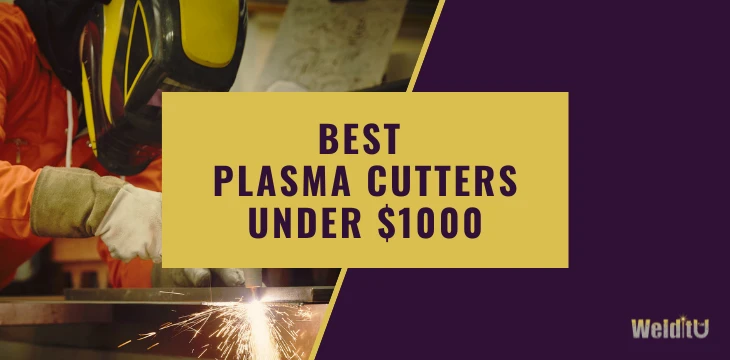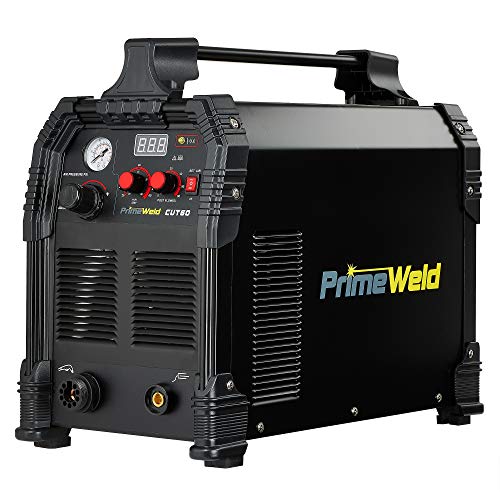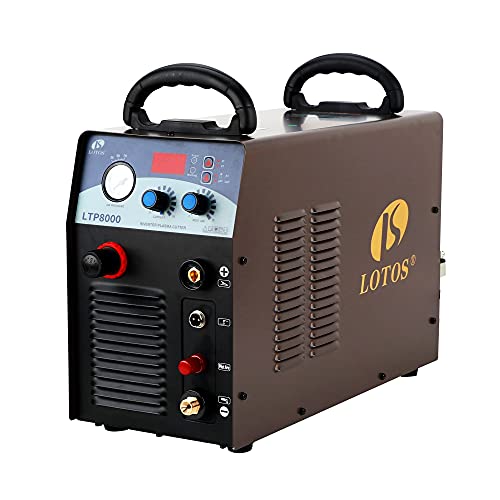Cut Project Times with the Best Plasma Cutters Under $1000
Cutting your metal stock to size before welding it can be a pain, right?
Compared to oxy-fuel torches, grinders, and band or chop saws, plasma cutting is safe, fast, and easy to learn. Plus, plasma cutters work with any conductive metal and easily cut tight curves and odd shapes.
You don’t have to break the bank to find a plasma cutter that’s right for you. My research found five plasma cutters under $1000 that can help you save time and money.
Jump to: Best Overall | Top Value | Most Powerful | Built-In Compressor | Best 120V | Guide

Best Plasma Cutters Under $1000 With Reviews
Plasma cutters selling for less than $1000 are ideal for DIYers and small fabrication shops, but not for heavy production use.
1. Top Choice
- Non-touch Pilot Arc
- Dual Voltage 120/240V
- 60% duty cycle at full power (60A)
- Clean cuts 3/4-in. steel at 12 IPM
- CNC connection for basic inputs
With a balance of power, price, and attractive features, the PrimeWeld CUT60 is the top choice for an all-around plasma cutter you can buy for less than $1000.
Overview
When dialed up to full power on 240V, you have a 60-amp plasma cutter that cuts cleanly through a 3/4-inch plate. At this thickness, the CUT60 cuts through steel at 12 IPM (inches per minute), stainless steel at 9.5 IPM, and aluminum at 13.6 IPM.
With an energy-efficient inverter power supply, it can provide 46 amps of power 100% duty cycle. At this level, you’re able to cut through 40 feet of 1/4-inch steel in ten minutes without stopping.
For light work, you can dial back the amperage and air pressure to make quick and clean cuts through 26 gauge sheet metal.
You’ll need a compressor capable of supplying 5 CFM (cubic feet per minute) of air at 80 PSI (pounds per square foot). The manufacturer recommends a 20-gallon tank.
PrimeWeld includes a good quality PT60 non-touch blowback torch with pilot arc and easy-to-source consumables. The torch includes an impressive 20-foot lead cable. They fit both leads with convenient Euro-style quick connectors.
A blowback start moves the energized electrode with air pressure. This creates a gap and causes a spark to trigger the arc. Because it doesn’t rely on touching the electrode to the workpiece or using a high frequency (HF) signal to fire the arc (that may interfere with electronics), a blowback plasma cutting torch can pair with a CNC table.
In fact, the cut 60 includes a CNC port for basic inputs and a matching plug you can use to connect to a CNC machine. The owner’s manual includes a full pin-out diagram to make this easy for you.
While they manufacture this plasma cutter in China, PrimeWeld provides US-based support out of New Jersey. The tech support staff are excellent and this cutter includes a 3-year warranty on material workmanship and defects. This includes parts, labor, and shipping to and from their repair facility.
Other than handy reference and settings tables, along with detailed parts and circuit diagrams, the owner’s manual is a disappointment. It contains poor translations and a lot of information applying to welders rather than plasma cutters.
Pros
- CNC compatible
- Generous torch lead
- Manual includes settings and reference charts
- Simple euro-style connectors for torch and work clamp
- 3-year warranty (includes shipping)
- Adjustable post flow minimizes consumable wear
- US-based tech support
Cons
- Requires 50A circuit for 240V operation
- Manual needs improvement
- Requires a large air compressor
2. Budget Alternative
- No-touch HF pilot arc
- Dual voltage power
- 20-50 amp output range
- Cuts up to 3/4 in.
- Weighs under 23 lbs.
Overview
As an alternative to the 60-amp PrimeWeld machine, the Reboot RBC-5000DL plasma cutter can save you around $250 if 50 amps (1/2-inch clean cuts) is good enough, you don’t care about CNC use, and don’t mind a drop in product quality.
Beyond that, you’ll get a compact, and easy-to-carry cutter you can operate off a standard 120V outlet for light cutting up to 3/8 inch, or switch to 240V power to make rough cuts on a heavy 3/4-inch plate. For maximum cutting ability, you’ll want a 30-amp breaker protecting a 120V circuit and a 50-amp on 240V.
You get a 13-foot no-touch pilot arc torch with HF start, which works great, but may interfere with nearby electronics. You’ll save even more with low-cost consumables for the AG60 torch.
They include an air regulator and dryer combo that attaches to the rear of the plasma cutter. The provided connectors are cheap barbed fittings and plastic tubing, but they are easy to upgrade if needed.
You’ll need to provide at least 70 PSI of air pressure-but not over 110 PSI-at 3.3 CFM for maximum cutting performance.
Pros
- Lightweight and portable
- Dual-voltage 120/240V
- Includes air regulator/filter
- Good power for the cost
- Budget-friendly consumables
Cons
- Not CNC compatible
- Cheap barbed connectors and hose for air filter
- Ideal for occasional use up to 1/2 inch
3. Most Powerful – Best for Deep Cuts
- 1-inch clean cut on steel
- Output adjustable from 20 to 80 amps
- No-touch pilot arc or drag start
- 240-volt power input
Overview
The Lotos LTP8000 is the big brother to the popular and proven LTP5000 plasma cutter. This one produces 80 amps of power, enough to rough cut through 1.5 inches of steel plate. But it’s adjustable down to 20 amps to make precision cuts on the lightest sheet metal.
This is a 240V-only machine with an efficient inverter power source. This results in respectable duty cycle ratings of 60% @ 70A or 100% @ 65A. Put another way, this cutter can run continuously at 80% power for at least 10 minutes, without overheating. And that’s still enough juice to make a clean slice through 3/4-inch, or sever 1-inch mild steel.
To reduce operator fatigue during long cuts, enable 4T mode so you can release the trigger for continuous cutting.
You get a comfortably long 17-foot torch capable of both no-touch and contact (drag) starts. The LTP8000 uses HF technology for no-contact starts, so it may create electronic noise not suitable for pairing with CNC equipment.
Lead connections are conveniently on the front panel. Lotos didn’t use euro-style attachments, so you have three separate connections for the torch. Not a big deal unless you often break down for travel or storage.
Consumables are proprietary and more expensive than most other plasma cutters. But they are readily available.
Compared to many brands, Lotos uses a lot of metal in their equipment, so this machine weighs nearly 15 pounds more than the Reboot plasma cutter. But it’s still very easy to manage with its double handle grips.
A big plasma cutter uses a lot of air. This one needs 4.8 CFM at 75 PSI, so at a minimum, you’ll want a compressor similar to this one.
Pros
- Rough cuts up to 1.5 inches
- Includes air regulator/filter to mount on rear
- Long torch cable for mobility around work
- 4T trigger is perfect for long cuts
- Adjustable post-flow
- One-year warranty
Cons
- Not for CNC work
- Requires a 50-amp circuit
- Proprietary consumables
- Needs a lot of air
4. Onboard Compressor
- Cut anywhere with 120V household power
- Doesn't require external air supply
- Clean cuts up to 1/8 in. @ 10 IPM
- Ultra portable-weighs just 27 lbs.
- 12-foot torch and work leads
Overview
This is for anyone that wants to make thin cuts without the bother of an external air source. It’s a quality Hobart plasma cutter that’s perfect for light cutting on mobile jobs like HVAC work. It’s also popular with homeowners, hobbyists, and artists.
Powered by an efficient inverter power source and a built-in air supply, this portable plasma cutter plugs into a standard 120V outlet. It performs best on a 20A circuit and even operates on a small 3000-watt generator.
With only 12 amps of power, the cutting speed is a respectable 10 IPM on 1/8-inch mild steel but deteriorates quickly on thicker material. On 1/4-inch cuts, speed drops to 3 IPM.
You get 12-foot work and torch leads with a no-touch pilot arc torch. The torch restarts automatically to make cutting perforated metal panels a breeze. A fixed 20-second post-flow cools the torch after a cut to extend consumable life, but you can begin another cut immediately.
Hobart provides a strong warranty covering the power source for 5 years, switches and PC boards for 3 years, and the torch for a year.
Pros
- No need for separate air supply
- Cooling fan runs only as needed
- Auto post-flow extends consumable life
- Cuts on perforated metals
- Solid Hobart 5/3/1 warranty
Cons
- Expensive for power level
- Struggles to cut over 1/8 inches
- Limited duty cycle
- Flimsy standoff guide
5. Best 120V for DIYers
- Just 21.5 pounds
- Compact size
- Clean cuts 1/4-inch
- Drag torch start
- Pilot arc
Overview
Part of Forney’s popular Easy Weld line, this handy plasma cutter doesn’t weld but is simple to use. There’s only one control knob to set cutting output amperage, and three lights on the front will let you know if something isn’t right.
It’s ideal for anyone limited to 120V power outlets that rarely need to cut over 1/4-inch stock. Use a 20-amp outlet for best performance, but Forney includes an adapter so you can plug it into a 15-amp circuit when needed.
At under 22 pounds, it’s lightweight but maintains a solid feel thanks to the thick all-metal case. With a footprint of 15 by 8 inches, and standing 12 inches tall, this plasma cutting machine takes up little space in your shop. And it’s no hassle at all to take along to the job.
This machine cuts through thick metal at a faster rate than the Hobart cutter but does not have an onboard air supply. Fortunately, its need for air is minimal (60-100 psi @ 1.5 CFM), so a basic compressor will do the job.
Use the 1/4-inch quick connect fitting on the rear panel to connect your air supply. There’s also a built-in moisture separator that drains automatically.
A 13-foot torch lead helps you maneuver around your work. The pilot arc burns through paint and grease, assisting the main cutting arc to start on dirty materials. Because this is a drag torch, the tip must contact the material to start and maintain the arc.
Pros
- Compatible with small air compressors
- Drag torch allows accurate freehand cutting
- Sturdy, but lightweight construction
- Cuts perforated metals
- Simple operation
- Built-in moisture separator
- Diagnostic lights on the control panel
Cons
- Not CNC compatible
- Weak warranty
- Drag torch uses more consumables
SAFETY NOTE: Plasma cutters expose users to similar risks found with other welding and grinding activities. At a minimum, review the manufacturer’s safety information in the Operator’s Manual and see our article covering basic welding shop safety.
Buyer’s Guide
Arc Starting Types
A touch start plasma cutter relies on an external spark to start the arc. This occurs as the torch contacts material being cut. Some find this style, also called drag cutting, easier to use when tracing curves or intricate details and with freehand work. But constant contact with the work surface is hard on consumables, so expect to replace these components more often.
A no-touch start torch creates its own internal spark to start the cutting arc. A stand-off guide or drag cup fitted to the torch maintains a gap between the cutting tip and material, usually 1/16-1/8 of an inch.
Many no-touch torches trigger high voltage across a fixed gap to create a spark. Known as high-frequency (HF) start, this method creates electronic noise that may interfere with nearby electronics, including CNC machines.
An alternative no-touch system, known as blowback start, uses air pressure to move the energized electrode off its seat within the torch. The spark created in this gap doesn’t bother CNC machines. Building enough air pressure to move the electrode at the end of a long lead can take a moment. A brief delay between pulling the trigger and the arc starting is a characteristic of this method, also known as a non-HF start.
They may use a pilot arc feature in both touch, and no-touch, style torches. Not designed for cutting, this small, intense arc cleans the surface of the metal to establish continuity and create a path for the cutting arc.
Postflow
A feature that continues airflow after a cut, post-flow cools the torch, extending consumable tips and electrodes. Post-flow time may be a fixed number of seconds, or user adjustable to match the length of cut and power level used.
Air Supply
You’ll need a steady supply of dry, clean air for your plasma cutter to do its magic. Manufacturers list the recommended, or minimum, air pressure (PSI) and volume (CFM) for full cutting ability. If your air compressor can’t maintain both, cutting performance will suffer.
Water, oil, or other contaminants in the air will cause poor cutting performance and increase wear on consumables. Don’t rely solely on the filter supplied with the cutter, but also use a good multistage inline filter. Drain your air tank daily to extend its life, and your filters will last longer.
Input Power
For $1000, you can choose from plasma cutters that will run only from a standard 120V household power outlet, or more powerful machines that must have a 240V outlet like those used with an electric dryer.
Many buyers opt for the flexibility offered by a third option: multi-voltage plasma cutters designed to run on either 120V or 240V. Switching voltage input involves the use of a simple adapter plug or cable. And you may or may not need to flip a switch on the machine.
120 Volt
Most plasma cutters operating on 120V power (same as 110V or 115V) will cleanly cut steel up to 1/4-inch thick and sever up to 3/8-inch. This matches well with 120V welders, because welding 1/4-inch material is about their upper limit, as well.
As with welders, 120V plasma cutters work best on 20-amp circuits. Not all homes have them, but many have 20A outlets in the garage. Some manufacturers recommend a 30A circuit.
Most home outlets are 15A circuits. You can use them, but with reduced cutting ability.
240 Volt
In this price range, you can expect to buy a 240V (same as 220V or 230V) plasma cutter with the ability to make clean cuts on steel plates from one-half to one inch thick. Depending on the maximum output power-which ranges from 45 to 80 amps-the circuit will require a breaker of 30 to 60 amps.
More About Cutting Capacity
- Very thin or very thick metals are more difficult to plasma cut cleanly
- Use the lowest setting possible for the metal being cut-excess amperage wears consumables out faster and results in poor cuts with more edge cleanup
- Rule of thumb for cutting mild steel: 20A for first 1/8-inch and 10A for each additional 1/8-inch for clean cuts
- Decrease cut thickness 35-40% for aluminum, stainless steel, galvanized steel, brass or copper, or increase amperage 25-30%
- Cutting thicker metal requires more amperage and air pressure
- With rated input power and air supply, expect travel speeds of at least 10-12 IPM at maximum clean cutting thickness
- Cutting speeds can be 3 IPM, or less, when cutting material at the maximum rated sever thickness
The Bottom Line
In a field full of no-name, no-service, knock-off welding gear, PrimeWeld is developing a loyal following thanks to well-designed machines with customer-friendly technical and warranty service.
Their plasma cutter features dual-voltage power, so you can cut metal anywhere on 120V, or switch to 240V for 60-amp power to deal with the heavy work. You can even pair it with a CNC table. Plus, they cover it with a 3-year warranty covering all shipping costs.
The PrimeWeld CUT60 Plasma Cutter is the top pick best plasma cutter under $1000.





